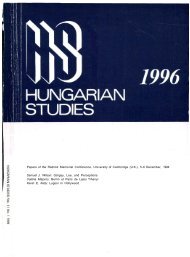The Canadian-American Review of Hungarian Studies - Vol. 4 ... - EPA
The Canadian-American Review of Hungarian Studies - Vol. 4 ... - EPA
The Canadian-American Review of Hungarian Studies - Vol. 4 ... - EPA
Create successful ePaper yourself
Turn your PDF publications into a flip-book with our unique Google optimized e-Paper software.
During the next several years, additional translations from Magyarpoetry followed. Work was started on the expansion <strong>of</strong> <strong>The</strong> MagyarMuse into a two-volume manuscript, intended for a new, enlargededition. A translation <strong>of</strong> Janos Arany's epic, <strong>The</strong> Death <strong>of</strong> King Bucla,was published in 1936 with the help <strong>of</strong> the Cleveland-based BenjaminFranklin Bibliographical Society, an organization dedicated to publishingbooks on <strong>Hungarian</strong> subjects. <strong>The</strong> translation <strong>of</strong> Arany's epicwas followed by a work on <strong>Hungarian</strong> grammar. Primer <strong>of</strong> <strong>Hungarian</strong>,published in installments in Payerle's Young Magyar-<strong>American</strong>. <strong>The</strong>ncame still more studies and translations, published from time to time inthe Slavonic and East European <strong>Review</strong>, and elsewhere. 28In 1936 Kirkconnell helped in the launching <strong>of</strong> the <strong>Hungarian</strong>Quarterly. <strong>The</strong> journal was the brain-child <strong>of</strong> Count lstvan Bethlen, one<strong>of</strong> Hungary's elder statesmen. Its primary purpose was to <strong>of</strong>fer theBritish and North <strong>American</strong> reading public a journal which wouldconvey information on Hungary's cultural life, political problems, andaspirations. Kirkconnell was one <strong>of</strong> the journal's first contributors. Hisarticle, "Hungary's Linguistic Isolation," expressed the hope that theperiodical would serve as an "open window," through which the worldcould "gaze into Hungary's lonely tower <strong>of</strong> linguistic isolation" and seethere "the vital personality <strong>of</strong> a gifted people." 29With the blessing and financial backing <strong>of</strong> individuals and institutionsin Hungary, the <strong>Hungarian</strong> Quarterly prospered for several years.<strong>The</strong> Second World War saw its demise. Since then, attempts to revive ithave failed primarily because <strong>of</strong> the lack <strong>of</strong> adequate financial resources.Although more than a generation has passed since the original<strong>Hungarian</strong> Quarterly folded, it has yet to be replaced by anotherperiodical <strong>of</strong> the same scope and quality, and dedicated to similarideals. 30During and after the Second World War new concerns, additionalduties and changed circumstances prevented Kirkconnell from devotingas much time and effort to verse translation from <strong>Hungarian</strong> asbefore. His work continued, but more sporadically. In 1947, an anthology,"Little Treasury <strong>of</strong> <strong>Hungarian</strong> Verse," appeared, followedmore than a decade later by translations <strong>of</strong> the Premonstratensiancanon Laszlo Mecs's poetry. Next came an anthology <strong>of</strong> the "freedomfighter" poetry <strong>of</strong> "Tibor Tollas"and others. But systematic work in thisfield could not be undertaken until after Kirkconnell's resignation fromthe Presidency <strong>of</strong> Acadia University in 1964. In 1967, he completed one<strong>of</strong> his old projects, a translation <strong>of</strong> Arany's Toldi. He also started workon still another, more complete anthology <strong>of</strong> Magyar verse. Next fol-
















